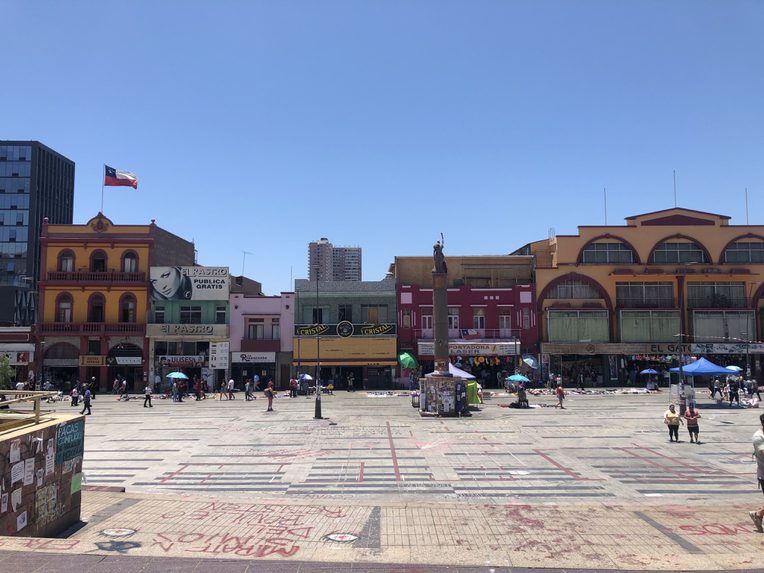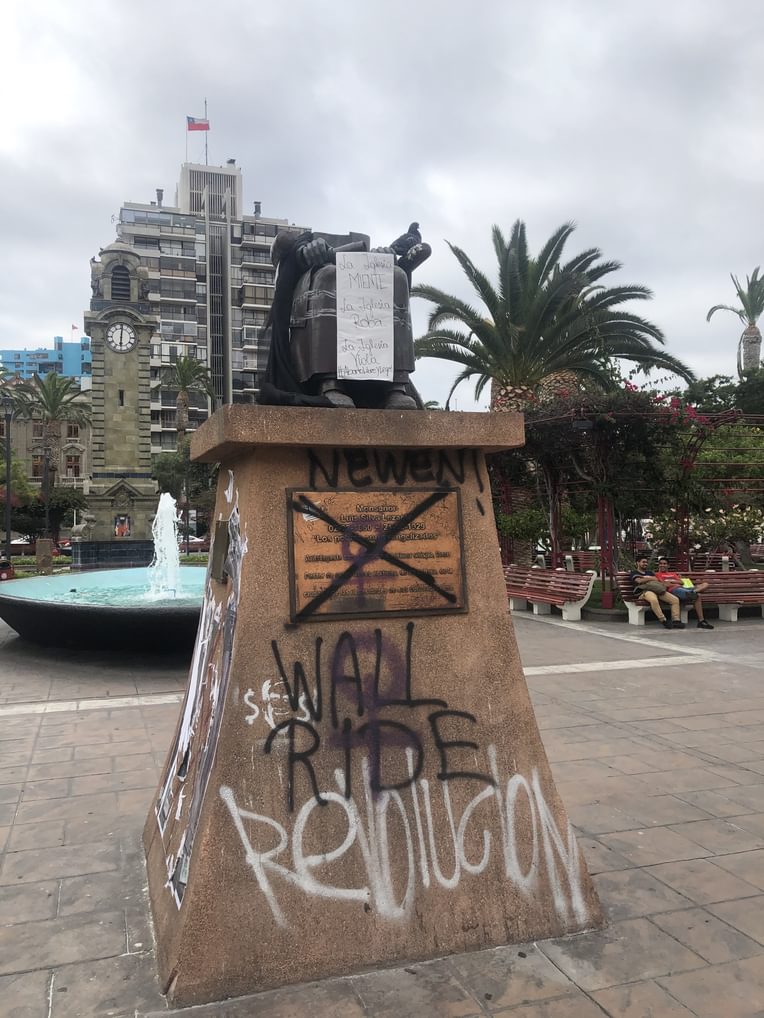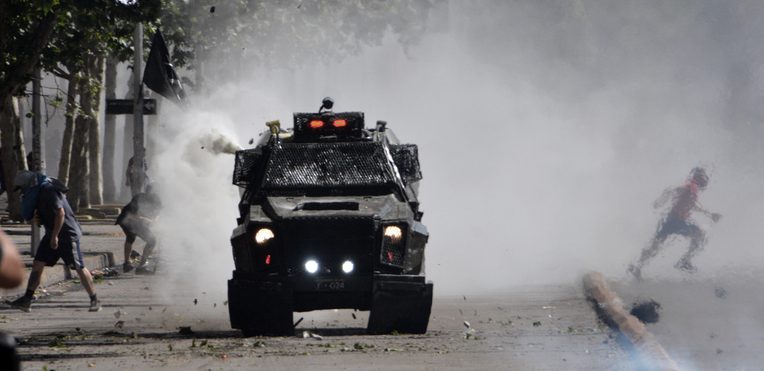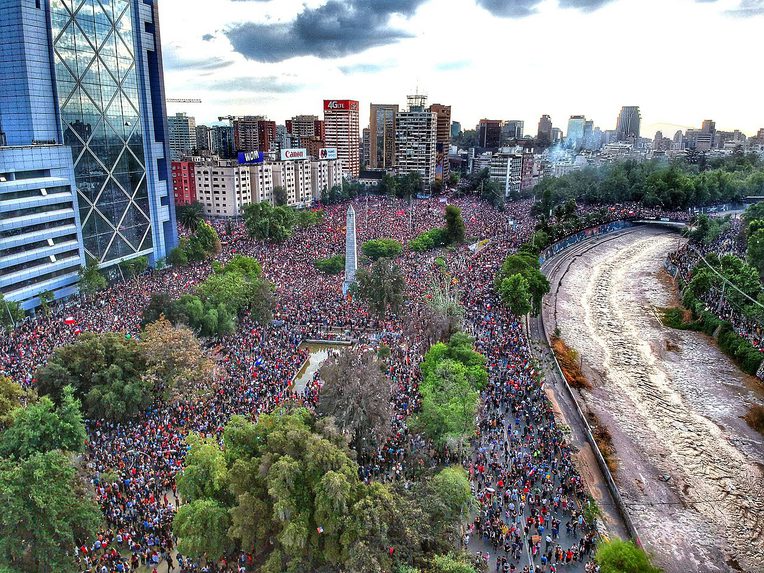Staying with the Rubble: Chile at a Crossroads
From the Series: Global Protest Movements in 2019: What Do They Teach Us?
From the Series: Global Protest Movements in 2019: What Do They Teach Us?

Juan, a migrant street vendor, sits proudly and calmly by his handwoven textiles, which he has displayed over a white cloth on the plaza floor. On multiple occasions during my dissertation research in the previous year, I had observed Juan pick up the white cloth by its four corners and, in the flash of a few seconds, hang it and the textiles it enveloped over his shoulder and flee the police to find another street corner to sell his textiles before having to flee again. “Everything has changed now,” Juan tells me. He has been an active part of multiple protests that have swept the city where the plaza is located during the last couple months. Juan alludes to the fact that, after the uprising, the police have been too busy to continue harassing him. Today Juan no longer seems vigilant. He is only one of a dozen or so migrant street vendors freely selling items on the outer edge of the plaza, which protesters rebranded the “Plaza of the Revolution.” Protesters also spray-painted the names of all those killed by the state during the uprising on the plaza esplanade. On this hot desert day, the esplanade is empty and the names shine back with force.

This interaction took place in Antofagasta, a large city in northern Chile, in mid-December 2019, two months after a nationwide uprising spread throughout the country. After meeting with Juan, I walked over to Antofagasta’s main square, only five blocks away from the Plaza of the Revolution. On my way, I saw that protesters had burned the largest chain drugstore in the city and scribbled slogans denouncing the privatization of pension funds on its melted tin security shutters. Upon arriving at the main square, the decapitated statue of Monsignor Luis Silva Lezaeta stood out among the rubble of the destroyed square. Using black graffiti, protesters had crossed out the description of Lezaeta on a bronze plaque underneath the statue as the city’s “first bishop, Good Shepherd of these northern lands, of its culture, of the city, and of the needs of his fellow citizens.” Above this description, they had written, instead, “Newen!” Newen means power in Mapudungun, the language of the Mapuche people, who are currently leading a years-long struggle to reclaim lands from the state in southern Chile. Draped over the knees of Lazaeta’s decapitated statue, a white banner reads, “The Church lies; the Church steals; the Church rapes.”

The traces left behind in Antofagasta by the nationwide uprising tell of a series of demands made from multiple and intersecting subjectivities. Feminist claims against gender-based violence meld with decolonial claims against the Church, anti-neoliberal claims against privatized social services, as well as critiques against state violence based on human rights. Juan’s support of the uprising may resonate with some of these claims, yet he tells me that, as a migrant, these claims seem foreign to him—his support of the uprising is specifically premised on his newfound freedom to sell on the streets. How can we think of the uprising from the perspective of Juan and many other everyday citizens who suddenly took to the streets in October 2019? In this brief reflection on the Chilean uprising, I write about, and against, a persistent tendency, in established political circles, academia, and the news media alike, to frame the ongoing struggle in Chile as following a clear historical trajectory and reducing its demands to coherent objectives by well-defined subjects. I suggest, rather, that ethnographers are uniquely positioned to sit with the struggle as messy and unfinished and, in that way, amplify rather than reduce the uprising’s historical, subjective, and political entailments.
In a short article suggestively titled “May ’68 Did Not Take Place,” philosopher Gilles Deleuze (2007, 233, emphasis in original) argues that in social uprisings, “there is always one part of the event that is irreducible to any social determinism, or to causal chains.” Determining the “consequences or effects” of a social uprising “according to lines of economic and political causality” may therefore lead us to lose sight of what the social uprising was to start with: “an unstable condition which opens up a new field of the possible” (Deleuze 2007, 233). Similarly, in her writings on the 2003 and 2005 Indigenous uprisings in Bolivia, sociologist and revolutionary Raquel Gutiérrez Aguilar (2014, xxvii) parts with “theorists … obsessed with fitting … acts into rigid frameworks.” Rather than starting with the “identification and delimitation of the various individual groups ... that come into conflict,” Gutiérrez Aguilar’s (2014, xxviii) “critical” approach “[privileges] the study of the moments in which the negation or overcoming of such individual status occurs” and new histories, subjects, and claims become possible. In what follows, I recapitulate the dominant interpretations of the Chilean uprising and instead offer an interpretation that foregrounds its process of becoming—understood as the reconfiguration of hegemonic historical, subjective, and political orders.
What renowned Chilean historian and public intellectual Gabriel Salazar has termed the “longest, most violent, and most significant ‘social uprising’ that the country has seen in its entire history” (my translation) started over one thousand kilometers south of Antofagasta, in the capital city of Santiago. On October 14, 2019, hundreds of high school and university students protested a thirty-peso increase in the Santiago metro fare by jumping turnstiles en masse. On October 18, the metro protests spiraled out of control and, over the course of the following weekend, protesters (allegedly) destroyed and paralyzed 80 of Santiago’s 136 metro stations, bringing the city to a standstill. As Sebastián Piñera’s right-wing government proceeded to frame protesters as a minoritarian group of renegades weaponizing the fare hike for political expediency, chants in the streets of Santiago retorted, “it is not thirty pesos, it is thirty years!” The slogan made it clear that protests were not about a sector-specific grievance by rowdy teenagers. Rather, as the slogan suggested, protests were about a nationwide outcry over thirty years of “democratic” governments that, since Chile transitioned from a military dictatorship to democracy in 1990, have effectively traded a merely nominal democracy for actual popular sovereignty. This “pact,” as it is often described, assured the military and authoritarian right parties previously in power that democracy would not threaten General Pinochet’s neoliberal economic model at the same time that it met citizen demands with what, for most Chileans, have increasingly appeared to be empty promises of liberal modernity.
In a sense, the Santiago metro was an apposite symbol for the protests. Founded in 1975 by the Pinochet regime, the metro’s “clean trains and stations full of art have been a metaphor for Chile as the ‘good student’ of Latin America, a country that has been able to increase its GDP more than 1,000 percent in 30 years, while many in the region struggle” (Garnham 2019). Yet, behind this facade of progress and prosperity, the metro—and the way it has segregated the city concurrent with its exorbitant fare price—also symbolizes the fallacy that the so-called “Chilean miracle” has shown itself to be for most Chileans over the past thirty years (Garnham 2019). A few days before the October uprising, Piñera infamously declared
that amid a “chaotic Latin America,” “our country is truly an oasis with a stable democracy.” Burning down the metro was a way for protesters to clearly state that far from the stable democracy they had been promised, Chilean society was quite literally rotten at its core.

The response to the uprising by Piñera’s right-wing government was swiftly authoritarian. On October 19, Piñera decreed a state of emergency and a curfew in Chile’s major cities and a day later announced, “we are at war against a powerful, implacable enemy.” Despite limited palliative measures (including a suspension of the metro fare hike), protests persisted, culminating in the largest march ever recorded in Chilean history: 1.2 million people protested in Santiago’s main plaza. Although protests were most prominent in Santiago, all of Chile’s cities saw an unprecedented number of people on the streets marching, rioting, burning, and looting government buildings, churches, banks, chain drug stores, and supermarkets in particular. The state violence with which the government responded, drawing parallels between the Piñera and Pinochet regimes, caused a human rights debacle: thirty-one people dead and 13,000 injured in the first two months of protests alone; 285 cases of people with severe eye trauma as a result of targeted police violence during October 2019; and 490 cases of violence against women, including torture and sexual assault, by March 2020. These events quickly gave the uprising its own momentum beyond the initial protest event and lent broad legitimacy to protesters.
What explains this apparently sudden and massive indictment by everyday citizens of what only a few days before the uprising the president had characterized as an “oasis” in Latin America? Although amazed at the timing and spread of the protest movement, many left-leaning pundits and academics had long foreseen the crash of the neoliberal model and read this moment as the culmination of this crash. Take, for instance, Carlos Ruiz, a prominent sociologist closely tied to a conglomeration of new leftist parties that emerged from the 2011 student movement. In various books leading up to the 2019 uprising, Ruiz describes a steady deterioration of what had once been a hegemonic system, which, during the “happy 1990s” (Ruiz 2015, 142), had been able to generate consensus among popular classes through promises of individual success and national prosperity. Promises of individual success and national prosperity, premised on a fully liberalized economy, were tacitly made in return for acceptance of the system of “protected democracy” inherited from Pinochet, where “the properly political was strictly separated and shielded from the social” (Ruiz 2015, 16). This order, which Ruiz identifies as neoliberal, made it such that “politics—and the economy— ... ceased to appear in the eyes of individuals as the result of a social dynamic,” and appeared instead as “something that is given to us, mandated on us” (24). These promises have failed to materialize and Chile continues to be one of the world’s most economically unequal countries. In the absence of the old corporatist welfare state, “which intervened in the configuration of social actors as a way of controlling their agreements and ‘pacts,’” (Ruiz 2015, 110) aggrieved individuals became increasingly “disenchanted with a political sphere that gave up on articulating horizons” (Ruiz 2015, 114, my translation). As Ruiz (2020) details in his recently published book on the October Revolution, these individuals have not coalesced into trade unions, student federations, and political parties, as had historically been the case. Instead, they have formed new social groups that cross middle and popular classes: the widely criminalized encapuchados (hooded ones in Spanish), feminist and anarchist collectives, urban rights groups, environmentalists, and many more. These new subjects promise a post-neoliberal future from outside a discredited formal political sphere.
Here, neoliberalism is an emically powerful concept referring concretely to the so-called “model” (modelo in Spanish), which refers to the subsidiary state and free-market economic system established by Pinochet’s 1980 constitution. In this sense, anthropological critiques of neoliberalism as a “broad, encompassing [framework]” that may “pose a challenge to the inductive orientation of the discipline” (Ganti 2014, 100) do not hold well for Chile, where neoliberalism in fact has immense ethnographic purchase, especially in the context of the current uprising. Protesters denounce expensive and exclusionary social services (particularly in education, health, social security, and housing) by explicitly using the term neoliberalism. Slogans from the Chilean uprising—that have traveled across the world—often refer to the precaritization of everyday life under neoliberalism: “to evade, not to pay, another form of struggle,” “[struggle] until dignity becomes a custom,” “Chile woke up,” to name but a few. A major article concerning the Chilean protests in the New York Times was unequivocally titled, “Dictatorship’s Legacy of Inequality Triggers Mass Protests.” And, indeed, for all its sudden massiveness, the October uprising can be traced to distinctly anti-neoliberal student movements against privatized education in 2006 and 2011, as well as to a continuous mass movement against privatized pensions since 2013. Tellingly, one of the earliest successes of protesters was to generate the conditions for a multi-party agreement to schedule a plebiscite on whether, and under which mechanism, to rewrite the 1980 constitution. Self-organized constitutional conventions emerged organically in neighborhoods throughout the country and in many cases took over functions typically monopolized by the state. On October 25, 2020, an overwhelming majority of Chileans (close to 80%) voted to re-write the constitution with a citizens-only constitutional convention.

Yet, does neoliberalism and the 1980 constitution accurately represent the milieu and trajectory of the uprising as a whole? After all, the metro fare hike that sparked the protests was driven not, as might be assumed from the standpoint of an anti-neoliberal critique, by a random market incentive, but rather by a legally scheduled tariff on the state company that owns and administers the Santiago metro. Moreover, the agreement to call for a plebiscite to rewrite the constitution was, in fact, met with suspicion and disapproval by protesters in the streets, many of whom considered it to be inadequate. Crucially, as Gabriel Salazar points out in his analysis, many of the features that protesters denounce and which Ruiz and others attribute to the neoliberal state—extreme economic inequality, a limited democracy, an autonomous economic sphere—are in fact perennial issues in Chile. Salazar thinks of the uprising from the perspective of the pueblo mestizo or bajo pueblo that has been a majority since the sixteenth century and that today constitutes “between 52 percent and 68 percent of the national population.” This pueblo “was born as a people without land, without legal access to property, without a proper memory, without a proper language, and—by virtue of a decision by the king of Spain and later for the convenience of a Chilean oligarchic mercantile class—without codified rights” (my translation). Only in 1931, when labor rights were first made into law, did this pueblo gain a semblance of rights and begin to become formal citizens. However, the descendants of the Creole elite still continue to deem the pueblo mestizo as huachos (bastards), afuerinos y merodeadores (outsiders and marauders), and, whenever they organize politically, enemigo interno (internal enemy). In this reading, the masses that took to the streets in 2019 have their historical roots in the rural bandits that tormented colonial haciendas through the 1940s and the rural-to-urban migrants who, beginning in the 1940s, settled the peripheries of cities and have since constantly held cities in check with recurrent episodes of pillage and plunder.
According to Salazar, neoliberal development was only able to “disguise the pueblo mestizo with a consumerist varnish that has not in any way altered its chronic marginality, its ... lack of identification with the Western culture that the Chilean oligarchy loves so much, and its deep rage for having been a subject without total integration into modern society for centuries” (my translation). In this sense, the radical separation between the state and society that Ruiz and others attribute directly to the neoliberal model can be traced at least to Diego Portales, the early nineteenth-century Creole conservative founder of the Chilean republic and an idol of the Pinochet regime, who “thought that democracy ... was absurd in the American countries, full of vices and where citizens lacked all virtue” (Larraín 2014, 88). This sentiment, rooted in racialized notions of the pueblo mestizo as non-modern, continues to undergird the deep suspicion with which the Chilean elite, still of agrarian aristocratic origin, views the participation of the pueblo in the political sphere. During the Pinochet dictatorship, this elite defended the idea that under Pinochet’s model of protected democracy, Chile became immune to the climate of populist insurgency otherwise pervasive in Latin America. It is this image, still current in Chile, that still bolsters the global campaign by Chilean elites and Western allies to portray Chile as an exceptional case that should serve as a model for the kind of development—neoliberal, capitalist, Western, colonial—that other Latin American nations should follow (Larraín 2014, 132–7). Thus, the contemporary image of Chile that the elite forged is that of a “country different from the rest of Latin America, a cold country with European features that differs from the tropicalisms of other countries in the region and that has overcome a premodern past” (Larraín 2014, 159, my translation).
Interpreting the October 2019 uprising as a revolt against neoliberalism and the 1980 constitution, then, may inadvertently undermine the ways in which the uprising has destabilized hegemonic historical, subjective, and political orders that precede and exceed neoliberalism. To return to the points made by Deleuze (2007) and Gutiérrez Aguilar (2014), doing so may close the field of the possible that the uprising opened by identifying causes, subjects, and claims with categories that existed before the uprising. As Deleuze (2007, 234) reminds us in the same piece, “the possible does not pre-exist, it is created by the event.” Since anti-neoliberal language is most available to protesters, it is not surprising that explicit claims are made against neoliberalism. This is not to say that protesters denouncing neoliberalism are engaging in false consciousness—that they say “neoliberalism,” but mean something different. Rather, I argue, the language of neoliberalism in the Chilean context speaks to more than what is generally encompassed by neoliberalism in other contexts; what exactly this is, remains an open question as the uprising unravels. When academics and pundits reduce the uprising to a reaction against neoliberalism and when the institutional left then channels the multiple and diverse demands made by protests as demands for social democratic constitutional reforms, this radical potential of the uprising is cut short.
Here, the difference between what Gutiérrez Aguilar (2014, xxiv, italics in original) terms the “practical scope of a struggle,” which includes the “elements that can be ‘observed’ from the outside,” and its “interior horizon,” which “can be studied by analyzing the discrepancy between what is done and not said, between what is said and not done, and in what implicitly or explicitly appears to be a desire or potential,” becomes highly relevant for an ethnographer. In a recently published article, leading Chilean anthropologist Francisca Márquez (2020) approaches the uprising from the perspective of the rubble left behind by the destruction of Santiago’s downtown at the hand of protesters. Márquez (2020, 8) points out that after the uprising, Santiago “became walkable, obligatorily walkable,” given the disruption of public transport systems. This allowed citizens to experience the city, in its current destroyed state, anew, and to imagine a new society amid the destroyed city. According to Márquez (2020, 7), rubble frees material from the functional and aesthetic value that it had in a previous order and allows the citizen to think about new possibilities of being. Seeing the uprising from the perspective of rubble resists the tendency to frame the ongoing struggle in Chile in a clear historical trajectory and reduce its demands to coherent objectives by well-defined subjects. Rubble stands for the ruins of “something that will never again be anything more than its illusory reconstruction—mimetic, phantasmagoric, and subsidiary in relation to the original model” (Márquez 2020, 10). In this sense, Márquez (2020, 10) argues, “far from tranquilizing us with certainties,” the rubble in downtown Santiago “operates in the plane of the indeterminate and the ambiguous: everything that calls upon us, but does not name us in any explicit manner.” Rather than imagining a possible reconstruction, the ethnographer pleads us to stay with the rubble and “accept that the plaza remains dirty and wrecked,” for it is under those conditions that we may see the emergence of a “diverse and motley occupation” (Márquez 2020, 10, my translation).

For Salazar, the fact that in 2019 the Chilean military did not—as in all previous occasions—all out massacre the pueblo mestizo as it asserted power opens an unprecedented era of new possibilities. March 2020, the time when Chilean summer vacations ended, was expected to be an intense month in the uprising leading to the plebiscite, originally scheduled for April 2020. Emergency quarantine and curfew laws passed as a result of the Covid-19 crisis, however, gave the Piñera regime sufficient cause to delay the plebiscite until October 2020 and to force protesters to put protests on hold. Conversely, the Covid-19 crisis has incidentally highlighted the inequalities that drive the protests and has also laid bare severe issues in the management of the crisis by the current authorities. How the uprising will unravel from now onward is, of course, yet to be seen. However, the manner in which it will occur will not be independent of the concepts that we develop to understand these occurrences and how these concepts might themselves shape the course of the struggle.
Deleuze, Gilles. 2007. “May ’68 Did Not Take Place.” In Two Regimes of Madness: Texts and Interviews, 1975–1995, edited by David Lapoujade, translated by Ames Hodges and Mike Taormina, 223–36. Cambridge, Mass.: MIT Press.
Ganti, Tejaswini. 2014. “Neoliberalism.” Annual Review of Anthropology 43: 89–104
Garnham, Juan Pablo. 2019. “Why Chile's Massive Protests Started with a Subway Fare Hike.” Bloomberg CityLab, October 26.
Gutiérrez Aguilar, Raquel. 2014. Rhythms of the Packahuti: Indigenous Uprising and State Power in Bolivia, translated by Stacey Alba D. Skar. Durham, N.C.: Duke University Press.
Larraín, Jorge. 2014. Identidad Chilena. Santiago, Chile: LOM Ediciones.
Márquez, Francisca. 2020. “Por una Antropología de los Escombros: El Estallido Social en Plaza Dignidad, Santiago de Chile.” Revista 180 45: 1–13.
Ruiz, Carlos. 2015. De Nuevo la Sociedad. Santiago, Chile: LOM Ediciones.
———. 2020. Octubre Chileno: La Irrupción de un Nuevo Pueblo. Santiago, Chile: Taurus.